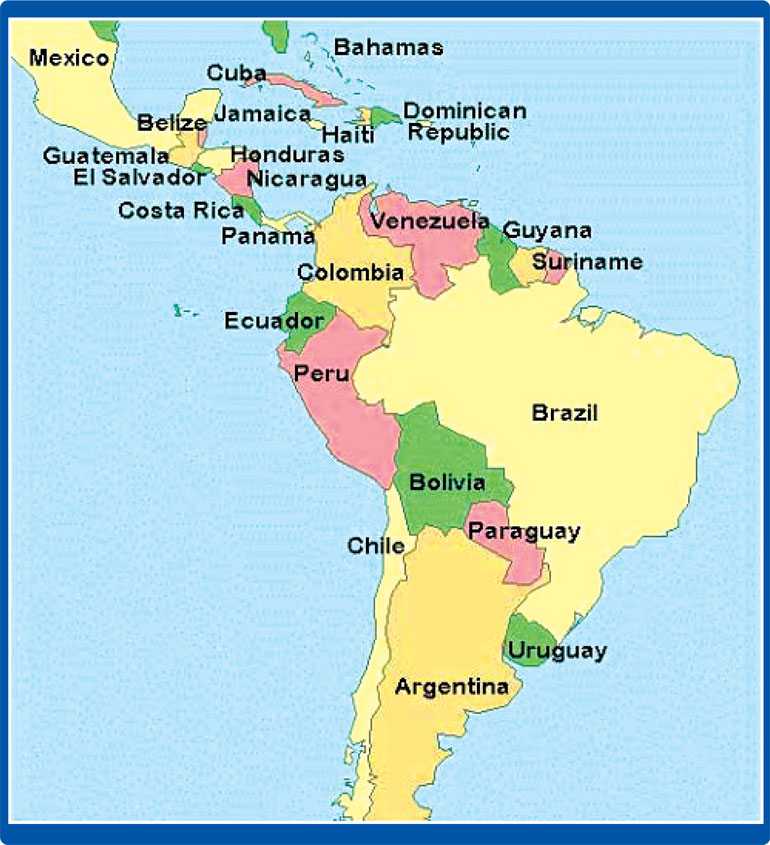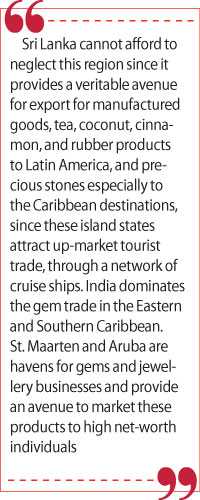Thursday Jan 08, 2026
Thursday Jan 08, 2026
Monday, 14 September 2020 00:00 - - {{hitsCtrl.values.hits}}

Latin America and the Caribbean is a neglected area in Sri Lanka’s foreign policy-making, academic research, and scholarship. The broad focus of this article is to give an overview of Latin America and the Caribbean. The narrow focus is to ascertain as to how Sri Lanka could improve relations with this region in a beneficial manner. This approach would be more relevant than a mere description of Latin America and the Caribbean, since Sri Lanka has recently decided to establish closer relations with this region for a variety of reasons.
First of all, it is useful to define the terms ‘Latin America’ and ‘the Caribbean.’ The term ‘Latin’ refers to those persons who speak the Spanish language, and thus the term ‘Latin’ refers to the Spanish speaking states in the Americas. The Caribbean has a different definition. It refers to independent and dependent territories in the Caribbean Sea. The independent states belonged to several ex-colonial powers such as Britain, France, and the Netherlands. These island states are also called the West Indies. However, in recent terms, with the birth of the Association of the Caribbean States (1994), the term ‘Caribbean’ is re-defined to include those countries which are abutting the Caribbean Sea in South America and Central America, in the same way as states belonging to the Indian Ocean Rim Association (IORAC) are determined.
Overview
A short overview by reference to the geography, history, and culture is necessary to understand the major issues confronting this region, before we consider their relevance to Sri Lanka.
Geographically the Latin American states spread from Mexico in North America to Argentina in South America. The land area exceeds 7.9 million square miles, and equals the landmass of Europe, and the US combined. In distance, it covers roughly an area from London to Cape Town. It is quicker to fly from Rio de Janeiro to Johannesburg than from Mexico City to Buenos Aires. This would demonstrate that Latin America and the Caribbean constitute a vast area.
It is important to note that Brazil is bigger than India in size, and Amazonia is the largest repository of biodiversity and constitutes the world’s largest ‘sink’ for carbon dioxide (CO2). The Galapagos is an off-shore island of Ecuador, where Charles Darwin wrote his famous book on ‘The Origins of the Species’ to dispute the birth of ‘homo sapiens’ to the horror of theologists.
Latin America can be further classified into several sub-regions such as the Andean States, Central American States, and Rio de la Plata. Similarly, the Caribbean can also be classified into Eastern, Western, Northern, and Southern Caribbean States. Eastern Caribbean is further classified into Windward and Leeward Islands. The Caribbean is now one of the most beautiful, up-market and popular tourist destinations in the world, with a galaxy of off-shore financial centres.
Historically, it must be emphasised that Latin American and the Caribbean civilisations were in existence before the arrival of Christopher Columbus to the New World over 500 years ago. In fact, the Mayans in Belize, Aztecs in Mexico, and the Incas in Peru had sophisticated civilisations. It is, therefore, a myth to say that Christopher Columbus “discovered” the Latin America and the Caribbean as if these civilisations and states were not in existence in the early 16th century. Since the conquest of these areas by the Spanish conquistadors and other colonial powers, the whole face of Latin America and the Caribbean changed rapidly. Approximately 14 million slaves from Africa, and later indentured labour from India, were shipped to this region for sugar and coffee plantation, and the original inhabitants of this region were decimated by the European powers, through the colonisation of the New World.
This region has contributed to the international community in literature, art, music, and sports in a substantial manner. In the arts – the famous Pablo Casals, Pablo Neruda, and the artist Pablo Picasso lived in Latin America. They have also produced a number of Nobel Prize winners. In sports, the West Indies, the former British Colonies in the Caribbean Sea dominated the game of cricket. Both Argentina and Brazil dominated the soccer scene. In music, the Latin American rhythms such as the Tango, Bossanova, Cha-cha-cha, Rhumba, and many other rhythms are popular in many parts of the world. The Calypso and Reggae rhythms, as well as the wonderful sonorities of the Caribbean Steel Drums, are taught and played in many Western capitals for the listening pleasure of millions of people throughout the world.
Relations with the US
This region cannot be fully understood without reference to the US. Since the promulgation of the Monroe Doctrine (1823), the US excluded any extra-hemispheric rivals from this region. It has followed a ‘hegemonic’ policy in the region in the Cold War period and interceded in the internal affairs of those states. It has sent troops to Dominican Republic, Panama, Nicaragua, Haiti, and Grenada in the recent past.
In the landmark Paramilitary Activities Case in 1986 (Nicaragua v. the US) the International Court of Justice (ICJ) held the mining of the Nicaraguan harbours and support to the Contras by the US was contrary to international law. The US continues to hold a tough stance on Cuba. It has passed the Helms-Burton Act to prevent other states from doing business with Cuba in regards to expropriated property4. However, at present, the most sensitive factor in US-Latin relations is the drug problem. The US holds a very strong position with regard to the extradition of traffickers. Nonetheless, the US is the driving force behind the economic expansion of this region through the North American Free Trade Agreement (NAFTA), Caribbean Basin Initiative (CBI), and several aid programs.
Major issues
It is important to understand the major issues confronting this region, and how the region has dealt with these issues are of relevance to Sri Lanka. Firstly, the question of promoting economic development is of paramount importance. The debt crisis in Latin America in the 1970s and 1980s has created difficulties for this region and will continue into the new millennium. The Latin American debt crisis arose because this region was unable to pay their debts which they borrowed from foreign banks. As this crisis began to grow, countries like Argentina and Brazil were really affected as they had to pay at least 50% of their Gross Domestic Product (GDP) in servicing the debt. The Baker Plan (1986) and Brady Plan (1989) ameliorated this situation but the debt crisis still continues to be a major problem in this region5.
Another important issue is the shift from dictatorship to democracy. In most Latin American countries, there are no tin-pot dictators. Most have gone back to multi-party democracy through Presidential systems or the Westminster model. Under Carlos Menon, Argentina has reverted to a Presidential system of government. Chile, Nicaragua and Panama have now established a democratic system of government. In most Latin American countries, democracy is the order of the day and dictatorships have taken a back-seat.
Finally, the viability of mini-states in the Caribbean is another major issue on the international agenda. After COVID, the mini-states are likely to suffer tremendously in the global economy. Previously, the Banana Issue has created huge trade disputes between the US and the European Union in regard to its preferential treatment. The viability of these states has been taken up at several Commonwealth Summits. A recent report on vulnerability by consultative groups of the Commonwealth Secretariat suggests many recommendations to overcome these difficulties.
Can we benefit from this region?
Sri Lanka can benefit a great deal from this region. The language barrier, lack of diplomatic representation, and geographic distance elude us from benefiting from this region in the following spheres.
Firstly, Latin America has taken a lead role in creating a ‘new platform’ to deal with the questions of globalisation and liberalisation of trade in a more effective manner at international fora. Jorge Castaneda’s initiative ‘Alternativa Lationamericana’ provides a Latin answer to neo-liberalism. This initiative is of significant value to South Asia, and in particular to Sri Lanka, as we share similarities with this region
Secondly, the Caribbean experiment with off-shore financial services is relevant to Sri Lanka at this moment. It is indeed a success story. The Caribbean off-shore companies and banks have attracted high net worth individuals and corporate clients. It has created new employment opportunities and numerous benefits to a large number of Caribbean citizens. It is an experiment which can be copied easily, and therefore it has some value in making Sri Lanka an off-shore financial centre (OFC) in South Asia. If Sri Lanka can be developed as an OFC to India and other Asian states in the same way as Mauritius is to India, we can expect some offshore banks and trusts and offshore companies to establish offices in Sri Lanka to do business with other Asian giants especially in providing insurance and syndicated loans.
Thirdly, if Sri Lanka were to encounter difficulties of importing oil from the Middle East countries, we may have to import oil from Latin America and Caribbean and our good relations with this region can help Sri Lanka to rely on them in a crisis situation. Republic of Guyana is now emerging as a new oil producing country in this region.
Improving relations with this region
This is a neglected area in Sri Lanka’s foreign policy-making. Successive governments have failed to establish closer relations with this region. In this regard careful cost-benefit analysis should be undertaken in foreign policy making.
Sri Lanka cannot afford to neglect this region since it provides a veritable avenue for export for manufactured goods, tea, coconut, cinnamon, and rubber products to Latin America, and precious stones especially to the Caribbean destinations, since these island states attract up-market tourist trade, through a network of cruise ships. India dominates the gem trade in the Eastern and Southern Caribbean. St. Maarten and Aruba are havens for gems and jewellery businesses and provide an avenue to market these products to high net-worth individuals. We have a comparative advantage in certain goods and services, too numerous to mention in specific terms in this short article. Hence, the selection of the appropriate countries for trade and diplomatic representation and penetration is of crucial importance.
It is also important to have closer relations, since any Sri Lankan who is vying for an international position in the future has very little chance to succeed without the support of this region. Almost, two decades ago, Judge Professor Christy Weeramantry, who was not a traditional diplomat, knew this too well in his election to the ICJ and worked extremely hard through expatriate Sri Lankans to win their support. On my invitation, he attended the Caribbean Heads of State Meeting in St. Kitts and Nevis and was able to form links with several Heads of State.
It is axiomatic that Sri Lanka’s relations cannot improve without adequate diplomatic and trade representations. It is unfortunate we have Ambassadors in Brazil and in Cuba and an Honorary Consuls in some Latin American and Caribbean countries. Cuban representation is for political rather than economic reasons, but this Embassy can be upgraded with proper accreditation to establish better relations with the neighbouring English-speaking Caribbean countries in the region.
In the long run, Cuba might be the number one tourist destination for North American tourists, and therefore we must get prepared to build good economic relations with Cuba, as the sale point for some of our goods to the tourists who may arrive from North America. It is unclear as to why the Caribbean states are served from the Sri Lankan Embassy in Washington DC and New York and not from Havana, Cuba – the heart of the Caribbean.
Recently, Sri Lanka obtained Observer status in the Organization of American States (OAS). It is a step in the right direction. It is also useful for Sri Lanka to join the Association of Small Island States (AOSIS) at least as an observer to improve relations with small island states in the Caribbean.
It is impossible to improve relations with this region without a good knowledge and understanding of Latin America and the Caribbean. Sri Lanka needs to send ambassadors who can speak the language and understand the culture of Latin America and the Caribbean to maximise the benefits and good relations with this region
(The writer was the former Director of the Bandaranaike Centre for International Studies (BCIS). He was also Ambassador to Austria and Permanent Representative to the UN in Vienna. He has worked and travelled extensively in Latin America and the Caribbean region as UN and Commonwealth Legal Expert/Adviser. At present, he is the Honorary Consul for Republic of Guyana in South America.)